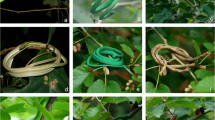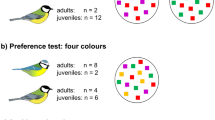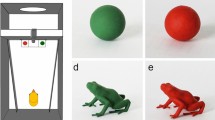Abstract
Red is a common colour signal in both aposematic warning displays, and in fruit displays. One common feature is that red is conspicuous against the natural background of the prey and fruits. However, there is a potential conflict between fruits and aposematic prey in how a bird predator should react to red colours, where fruits aim to attract birds and aposematic insects aim to ward off, often the same bird individuals. Here we investigate possible differences in red/green colour preferences of frugivorous, wild-caught, young blackcaps (Sylvia atricapilla), when food is either a fruit or an insect. Birds in two groups were presented with a series of pairs of food items that had been artificially painted red and green, in the order of (I) fruits, crickets and maggots, or (II) crickets, fruits, and maggots. Birds first presented with crickets or fruits differed in first attacks directed at the two colours: They showed no colour preference between fruits, but showed a clear preference for green over red crickets. Also, birds in both experimental groups clearly preferred green to red maggots. These results provide evidence that wild, frugivorous birds are able to differentiate between prey types, and show different colour preferences depending on whether food is insect or fruit. We conclude that blackcaps show an attack bias against red insects, and that one important function of the signal in insects, is to inhibit attack after discovery. However, the lack of preference for red fruits suggests other functions to red fruit displays, such as facilitating discovery per se, rather than directly stimulating attack after discovery.
Similar content being viewed by others

References
Altshuler DL (2001) Ultraviolet reflectance in fruits, ambient light composition and fruit removal in a tropical forest. Evol Ecol Res 3:767–778
Bairlein F (1996) Fruit-eating in birds and its nutritional consequences. Comp Biochem Physiol 113A:215–224
Burkhardt D (1982) Birds, berries and UV. Naturwissenschaften 69:153–157
Burns KC, Dalen JL (2002) Foliage color contrasts and adaptive fruit color variation in a bird-dispersed plant community. Oikos 96:463–469
Butcher GS, Rohwer S (1988) The evolution of conspicuous and distinctive coloration for communication in birds. Curr Ornithol 6:51–108
Collias NE, Collias EC (1967) A field study of Red Jungle Fowl in north-central China. Condor 69:360–386
Cott HB (1940) Adaptive coloration in animals. Methuen, London
Darwin CR (1871) The decent of man, and selection in relation to sex. Princeton University Press, New Jersey
Edmunds M (1974) Defence in animals: a survey of anti-predator defences. Longman, Harlow
Eggers S (2000) Compensatory frugivory in migratory Sylvia warblers: geographical responses to season length. J Avian Biol 31:63–74
Ellegren H, Fransson T (1992) Fat loads and estimated flight-ranges in four Sylvia species analysed during autumn migration at Gotland, South-East Sweden. Ring Migr 13:1–12
Gamberale-Stille G, Tullberg BS (2001) Fruit or aposematic insect? Context dependent colour preferences in domestic chicks. P Roy Soc Lond B 268:2525–2529
Guilford T (1990) The evolution of aposematism. In: Evans DL, Schmidt JO (eds.), Insect defenses. Adaptive mechanisms and strategies of prey and predators. State University of New York press, New York, pp 23–61
Guilford T, Dawkins MS (1991) Receiver psychology and the evolution of animal signals. Anim Behav 42:1–14
Harrison C (1985) A field guide to the nests, eggs and nestlings of European birds. Collins, London
Hartley L, Waas J, O’Connor C, Matthews L (2000) Colour preferences and coloured bait colsumption by weka Gallirallus australis, an endemic New Zealand rail. Biol Conserv 93:255–263
Honkavaara J, Siitari H, Viitala J. (2004) Fruit colour preferences of redwings (Turdus iliacus): experiments with hand-raised juveniles and wild-caught adults. Ethology 110:445–457
Jourdie V, Moureau B, Bennett ATD, Heeb P (2004) Ultraviolet reflectance by the skin of nestlings. Nature 431:262
Lee WG, Weatherall IL, Wilson JB (1994) Fruit conspicuousness in some New Zealand Coprosma (Rubiaceae) species. Oikos 69:87–94
Maynard Smith J, Harper D (2003) Animal signals. Oxford University Press, New York
McPherson JM (1988) Preferences of cedar waxwings in the laboratory for fruit species, colour and size: a comparison with field observations. Anim Behav 36:961–969
Pettersson J, Hasselquist D (1985) Fat deposition and migration capacity of Robins Erithacus rubecula and Goldcrests Regulus regulus at Ottenby, Sweden. Ring Migr 6:66–76
Puckey HL, Lill A, O’Dowd DJ (1996) Fruit color choices of captive Silvereyes (Zosterops lateralis). Condor 98:780–790
Radwan J (1993) Are dull birds still dull in UV? Acta Orn 27:125–130
Ridley HN (1930) The dispersal of plants throughout the world. Reeve, Ashford, UK
Rubinoff I, Kropach C (1970) Differential reactions of Atlantic and Pacific predators to sea snakes. Nature 228:1288–1290
Ruxton GD, Sherratt TN, Speed MP (2004) Avoiding attack. The evolutionary ecology of crypsis, warning signals and mimicry. Oxford University Press, New York
Schmidt V, Schaefer HM (2004) Unlearned preference for red may facilitate recognition of palatable food in young omnivorous birds. Evol Ecol Res 6:919–925
Schmidt V, Schaefer HM, Winkler H (2004) Conspicuousness, not colour as foraging cue in plant–animal signalling. Oikos 106:551–557
Schuler W, Hesse E (1985) On the function of warning coloration: a black and yellow pattern inhibits prey-attack by naive domestic chicks. Behav Ecol Sociobiol 16:249–255
Schuler W, Roper TJ (1992) Responses to warning coloration in avian predators. Adv Stud Behav 21:111–146
Siitari H, Honkavaara J, Viitala J (1999) Ultraviolet reflection of berries attracts foraging birds. A laboratory study with redwings (Turdus iliacus) and bilberries (Vaccinium myrtillus). Proc R Soc Lond B 266:2125–2129
Sillén-Tullberg B (1985a) Higher survival of an aposematic than of a cryptic form of a distasteful bug. Oecologia 67:411–415
Sillén-Tullberg B (1985b) The significance of coloration per se, independent of background, for predator avoidance of aposematic prey. Anim Behav 33:1382–1384
Smith SM (1975) Innate recognition of coral snake pattern by a possible avian predator. Science 187:759–760
Smith SM (1977) Coral-snake pattern recognition and stimulus generalisation by naive great kiskadees (Aves: Tyrannidae). Nature 265:535–536
Svensson L (1992) Identification guide to European Passerines. Stockholm, Sweden
Swynnerton CF (1916) On the coloration of the mouth and eggs of birds. I. The mouths of birds. Ibis 4:264–294
Traveset A, Willson MF, Verdú M (2004) Characteristics of fleshy fruits in southeast Alaska: phylogenetic comparison with fruits from Illinois. Ecography 27:41–48
Wheelwright NT, Janson CH (1985) Colours of fruit displays of bird dispersed plants in two tropical forests. Am Nat 126:777–799
Wiklund C, Järvi T (1982) Survival of distasteful insects after being attacked by naive birds: a reappraisal of the theory of aposematic coloration evolving through individual selection. Evolution 36:998–1002
Willson MF (1994) Fruit choices by captive american robins. Condor 96:494–502
Willson MF, Comet TA (1993) Food choices by northwestern crows: experiments with captive, free-ranging and hand-raised birds. Condor 95:596–615
Willson MF, Graff DA, Whelan CJ (1990) Color preferences of frugivorous birds in relation to the colors of fleshy fruits. Condor 92:545–555
Willson MF, Thompson JN (1982) Phenology and ecology of color in bird-dispersed fruits, or why some fruits are red when they are ‘green’. Can J Bot 60:701–713
Willson MF, Whelan CJ (1989) Ultraviolet reflectance of fruits of vertebrate-dispersed plants. Oikos 55:341–348
Willson MF, Whelan CJ (1990) The evolution of fruit color in fleshy-fruited plants. Am Nat 136:790–809
Acknowledgments
We would like to thank the anonymous referees for their valuable comments on the manuscript. This study was financed by the Swedish Research Council (VR) to GGS and BT.
Author information
Authors and Affiliations
Corresponding author
Rights and permissions
About this article
Cite this article
Gamberale-Stille, G., Hall, K.S.S. & Tullberg, B.S. Signals of profitability? Food colour preferences in migrating juvenile blackcaps differ for fruits and insects. Evol Ecol 21, 99–108 (2007). https://doi.org/10.1007/s10682-006-9126-8
Published:
Issue Date:
DOI: https://doi.org/10.1007/s10682-006-9126-8



